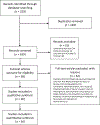Evaluating Medicaid expansion benefits for patients with cancer: National Cancer Database analysis and systematic review
- PMID: 35559947
- PMCID: PMC8276859
- DOI: 10.1016/j.jcpo.2021.100292
Evaluating Medicaid expansion benefits for patients with cancer: National Cancer Database analysis and systematic review
Abstract
Background: Insurance status modifies healthcare access and inequities. The Affordable Care Act expanded Medicaid coverage for people with low incomes in the United States. This study assessed the consequences of this policy change for cancer care after expansion in 2014.
Methods: National Cancer Database (NCDB) public benchmark reports were queried for each malignancy in 2013 and 2016. Furthermore, a systematic search [PubMed, Embase, Scopus and Cochrane] was performed. Data on insurance status, access to cancer screening and treatment, and socioeconomic disparities in these metrics was collected.
Results: Two-tailed analysis of the NCDB revealed that 14 out of 18 eligible states had a statistically significant increase in Medicaid-insured patients with cancer after expansion. The average percentage increase was 51 % (13.2-204 %). From the systematic review, 229 studies were identified, 26 met inclusion. All 21 relevant articles reported lower uninsured rates. The average increase of Medicaid-insured patients was 77 % (9.5-230 %) and the average decrease of uninsured rates was 55 % (13.4-73 %). 15 out of 21 articles reported increased access to care. 16 out of 17 articles reported reductions in inequities.
Conclusion: Medicaid expansion in 2014 increased the number of insured patients with cancer. Expansion also improved access to screening and treatment in most oncologic care, and reduced socioeconomic disparities. Further studies evaluating correlative survival outcomes are needed.
Policy summary: This study informs debates on expansion of Medicaid in state governments and electorates in the United States, and on health insurance reform broadly, by providing insight into how health insurance can benefit people with cancer while revealing how less insurance coverage could harm patients with cancer before and after their diagnosis. This study also contributes to discussions of health insurance mandates, subsidized coverage for people with low incomes, and covered healthcare services determinations by public and private health insurance providers in other countries.
Keywords: Early detection of cancer; Health insurance; Health services accessibility; Healthcare disparities; Patient protection and affordable care act.
Copyright © 2021 Elsevier Ltd. All rights reserved.
Conflict of interest statement
Figures
Similar articles
-
Has the Affordable Care Act Been Associated with Increased Insurance Coverage and Early-stage Diagnoses of Bone and Soft-tissue Sarcomas in Adults?Clin Orthop Relat Res. 2021 Mar 1;479(3):493-502. doi: 10.1097/CORR.0000000000001438. Clin Orthop Relat Res. 2021. PMID: 32805094 Free PMC article.
-
Surveillance for Health Care Access and Health Services Use, Adults Aged 18-64 Years - Behavioral Risk Factor Surveillance System, United States, 2014.MMWR Surveill Summ. 2017 Feb 24;66(7):1-42. doi: 10.15585/mmwr.ss6607a1. MMWR Surveill Summ. 2017. PMID: 28231239 Free PMC article.
-
Association of the Patient Protection and Affordable Care Act With Insurance Coverage for Head and Neck Cancer in the SEER Database.JAMA Otolaryngol Head Neck Surg. 2018 Nov 1;144(11):1052-1057. doi: 10.1001/jamaoto.2018.1792. JAMA Otolaryngol Head Neck Surg. 2018. PMID: 30242321 Free PMC article.
-
The Affordable Care Act's Medicaid Expansion and Impact Along the Cancer-Care Continuum: A Systematic Review.J Natl Cancer Inst. 2020 Aug 1;112(8):779-791. doi: 10.1093/jnci/djaa043. J Natl Cancer Inst. 2020. PMID: 32277814 Free PMC article.
-
A Critical Analysis of Obamacare: Affordable Care or Insurance for Many and Coverage for Few?Pain Physician. 2017 Mar;20(3):111-138. Pain Physician. 2017. PMID: 28339427 Review.
Cited by
-
Examining Employment Status, Paid Sick Leave, and Access to Care in Relation to Colorectal Cancer Screening Among U.S. Workers: A Structural Equation Modeling Approach.Cancer Control. 2025 Jan-Dec;32:10732748251347731. doi: 10.1177/10732748251347731. Epub 2025 Jun 4. Cancer Control. 2025. PMID: 40464597 Free PMC article.
-
Medicaid Expansion and Postoperative Mortality in Women with Gynecologic Cancer: A Difference-in-Difference Analysis.Ann Surg Oncol. 2023 Mar;30(3):1508-1519. doi: 10.1245/s10434-022-12663-1. Epub 2022 Oct 30. Ann Surg Oncol. 2023. PMID: 36310311 Free PMC article.
-
Changes in Cancer Mortality by Race and Ethnicity Following the Implementation of the Affordable Care Act in California.Front Oncol. 2022 Jul 13;12:916167. doi: 10.3389/fonc.2022.916167. eCollection 2022. Front Oncol. 2022. PMID: 35912225 Free PMC article.
-
Medicaid expansion is associated with increased 1-year survival for primary malignant brain tumors.Neurooncol Adv. 2023 Mar 4;5(1):vdad022. doi: 10.1093/noajnl/vdad022. eCollection 2023 Jan-Dec. Neurooncol Adv. 2023. PMID: 37051332 Free PMC article. No abstract available.
-
Obamacare: A bibliometric perspective.Front Public Health. 2022 Aug 12;10:979064. doi: 10.3389/fpubh.2022.979064. eCollection 2022. Front Public Health. 2022. PMID: 36033824 Free PMC article.
References
-
- Howlader N, et al., SEER Cancer Statistics Review, 1975–2017. National Cancer Institute, 2019.
Publication types
MeSH terms
Grants and funding
LinkOut - more resources
Full Text Sources
Medical
Miscellaneous



